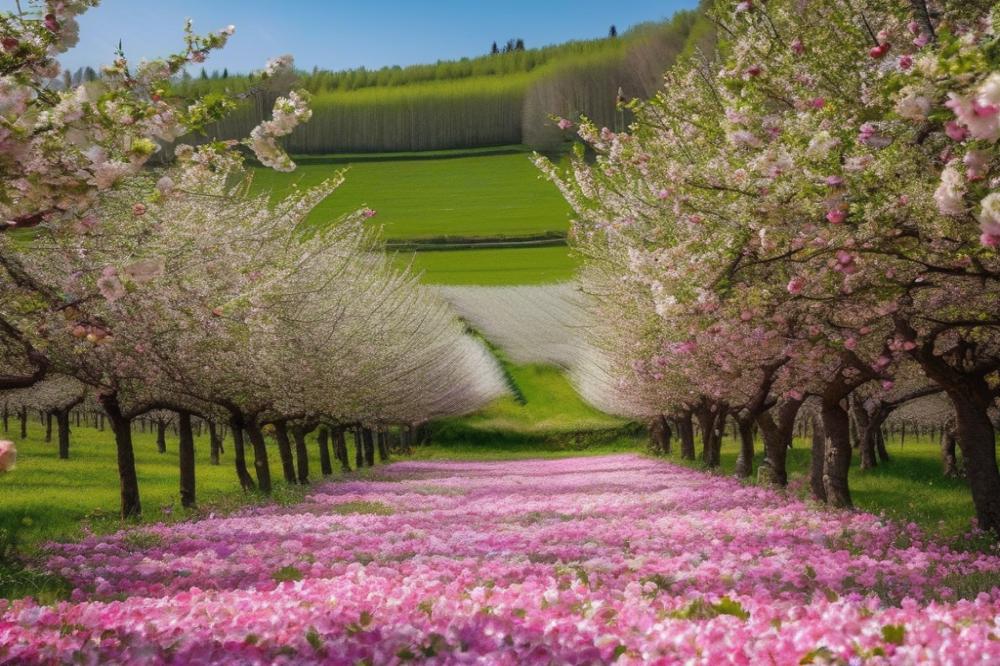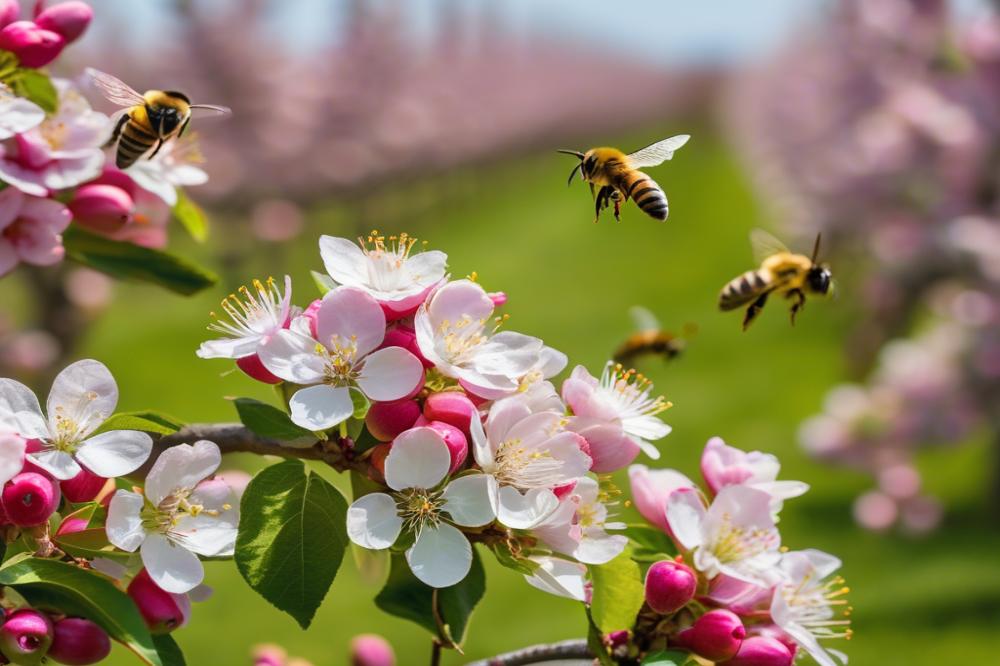The Role of pollinators in Successful apple cultivation
The success of apple cultivation heavily relies on the presence of certain small creatures, especially bees. These insects are central to the process of pollination, which is essential for producing apples. When bees visit flowering plants, they pick up pollen and carry it to other flowers. This simple act leads to fertilization, allowing fruit trees to bear the delicious apples we enjoy.
Honeybees, among others, significantly enhance crop yield. They help ensure that blossoms transform into fruits. Without these diligent creatures, many fruits would not develop properly, leading to lower harvests. This connection between bees and agriculture is crucial for farmers and consumers alike. When pollination occurs, trees produce more apples, leading to a better supply in the markets.
The influence of pollinators extends beyond just fruit production. They play an important role in maintaining biodiversity. Healthy populations of bees and other insects contribute to various ecosystems. They support the growth of flowering plants necessary for various wildlife. Agriculture practices that prioritize these creatures can foster a more sustainable environment. These organisms provide not just food, but also crucial ecosystem services that keep the natural balance intact.
In summary, understanding the role of these vital helpers in apple cultivation is vital. Appreciating their contribution can guide us toward more effective agricultural methods in the future. By protecting and encouraging pollinator populations, we can enhance not just our fruit harvests but also the health of our ecosystems.
Understanding Pollination

Pollination is the process by which pollen from the male part of a flower reaches the female part, allowing fertilization to occur. This process is crucial for fruit trees, including apple orchards. Without effective pollination, many flowering plants would not produce fruit, which directly impacts the food supply. In apple cultivation, pollination leads to the formation of fruit and ensures a good harvest.
Bees play a significant role in facilitating pollination. As they move from flower to flower, searching for nectar, they inadvertently transfer pollen. This natural behavior is vital for the reproductive cycle of many plants. Their constant movement between blooms not only helps in fertilizing flowers but also supports the growth of seeds within those fruits.
Honeybees and native bees are essential contributors to apple orchards. Honeybees are known for their efficiency in pollinating crops. They are social insects and live in large colonies, which makes their population density high in agricultural areas. This density increases the chances of successful pollination. On the other hand, native bees offer unique advantages. They often have different foraging behaviors and preferences that enable them to visit flowers at various times, extending the pollination period.
The collaboration between honeybees and native bees in apple orchards fosters biodiversity. A diverse array of bee species helps improve crop yield and overall health of the ecosystem. Integrated agriculture practices that support both types of bees may lead to more sustainable agriculture. By promoting habitats that attract different bees, farmers can create a balanced ecosystem that benefits both production and biodiversity.
In summary, proper understanding of how pollination works, alongside the vital work of bees, is essential to successful apple cultivation. Recognizing the importance of these insects can lead to improved agricultural strategies that enhance not only the yield but also the health of fruit trees and the environment.
The Lifecycle of apple trees and Pollination

apple trees have a fascinating lifecycle that begins with their flowering process. During spring, when temperatures rise, the trees burst into bloom. Flowers emerge in various shades, from pale pink to white, catching the eye of anyone who passes by. This period is crucial because it marks the moment when pollination can occur.
The timing of flowering matches perfectly with the activity of bees. Honeybees, in particular, seek out the nectar and pollen produced by these blooming flowers. As they move from flower to flower, they inadvertently transfer pollen, enabling the process of reproduction. This synchronization between flowers and bee activity is vital for the success of fruit trees.
Effective pollination plays a central role in the development of fruit. When a flower receives pollen, the fertilization of ovules occurs. Successfully fertilized flowers eventually develop into apples. The quantity and quality of these fruits depend on how well the earlier process of pollination took place. An increase in pollination typically results in a higher crop yield, benefiting both farmers and consumers.
This relationship between flowering plants and the bees is more than just beneficial; it highlights the importance of biodiversity in agriculture. By cultivating apple trees and supporting insect populations, we promote ecosystem services. Sustainable agriculture practices are essential to maintain this balance, ensuring that both trees and pollinators thrive.
Enhancing Pollinator Populations in Your Garden

Diversity in flowering plants is crucial for attracting various pollinators to your garden. Different species offer distinct blossoms and nectar, appealing to a wide range of bees and other insects. Biodiversity helps create a robust ecosystem. A diverse garden can support these important visitors throughout their foraging season. Planting a mixture of flowers ensures that something is blooming at different times, providing food from spring to fall.
When choosing plants to accompany apple trees, consider incorporating species like lavender, sunflowers, and clover. Lavender’s fragrant blooms entice honeybees, making it a fantastic complement to fruit trees. Sunflowers not only provide beauty but also attract many beneficial insects. Clover, being a ground cover, improves soil health while offering forage for bees. The combination of these plants creates a welcoming environment for pollinators.
Sustainable agriculture practices play a significant role in promoting the health of pollinators. Avoiding chemical pesticides is one of the best choices you can make. Instead, using organic alternatives helps keep both the garden and its visitors safe. Additionally, planting native flowering plants enhances crop yield by providing natural habitats. Utilizing cover crops also improves soil fertility and encourages a balanced ecosystem.
Providing water sources can attract visitors as well. A simple dish with pebbles and water can serve as a bath for bees. Keeping the area free of monocultures is important too. Diverse habitats will attract various species, creating a supportive environment for all forms of life. Every small change in your gardening methods encourages these crucial visitors to thrive.
Challenges Facing Pollinators
Bee populations face many threats today. Pesticides used in farming can harm these essential insects. Habitat loss also plays a significant role in their decline. Urban development and changing land use reduce the areas where bees can forage. As flowering plants disappear, bees struggle to find enough food.
The implications for apple cultivation are serious. Successful pollination is crucial for fruit trees, including apple trees. Without enough pollinators, the crop yield can drop significantly. A lack of bees can lead to fewer apples and lower quality fruit. This not only affects farmers’ profits but also the variety of apples available to consumers.
Solutions exist to help protect these important insects. Sustainable agriculture practices focus on reducing pesticide use and promoting biodiversity. Encouraging farmers to plant wildflowers alongside their crops can provide bees with better foraging options. Creating bee habitats and preserving local ecosystems is vital. Education about the importance of honeybees and other species is also essential. Awareness can lead to more community involvement in conservation efforts.
Practical Tips for Gardeners
Creating a thriving garden requires attention to many details. Start by grouping your fruit trees and flowering plants. This method attracts more bees and aids in their movement from blossom to blossom. A cluster of plants can be an inviting space for them. Consider varieties that bloom at different times. This approach extends the flowering season and provides food throughout the year.
Maintaining natural habitats near your garden can also support healthy populations of these beneficial insects. Planting native flowers helps attract local bee species. Additionally, leaving some areas of your yard undisturbed can create homes for various pollinators. A diverse ecosystem often results in better crop yield. Healthy biodiversity is crucial for sustainable agriculture and robust food production.
Avoiding pesticides is another essential practice. Chemicals can harm bees and disrupt the delicate balance of your garden’s ecosystem services. Opt for organic methods to manage pests. Handpicking, using traps, or introducing beneficial insects can help control unwanted pests without harming other creatures.
Community initiatives can enhance pollinator-friendly environments. Engaging with local gardening clubs or environmental organizations can encourage these healthy ecosystems. Share information about planting native species with neighbors. Work together to create green corridors that connect various gardens. This will benefit not only your plants but also support the larger ecosystem.
Remember, every small action counts. While gardening, always think of how it impacts the world around you. By implementing these strategies, you foster resilience in your garden and promote a healthier agricultural landscape for everyone.
Final Thoughts
Understanding the critical role of pollinators in successful apple cultivation is essential for any aspiring gardener. These small creatures contribute significantly to the pollination of apple blossoms, allowing trees to produce the fruit we all enjoy. Without them, yields would dramatically decrease, impacting both local economies and our ability to enjoy fresh apples.
The connection between biodiversity and sustainable agriculture cannot be overlooked. Healthy ecosystems support various species, each playing a specific role in our food supply. When gardens and orchards thrive in harmony with nature, crops yield better and communities prosper.
Every gardener has the power to cultivate a more inviting environment for bees and other beneficial insects. Simple actions can make a difference. Planting native flowers provides food sources, while avoiding harmful pesticides protects these vital species. By taking these steps, you can enhance your apple harvest and contribute to the health of our planet.
In conclusion, fostering pollinator health is not just a personal choice; it is a shared responsibility. Successful apple cultivation relies heavily on diverse and thriving populations of small creatures. Let’s work together to create landscapes that bloom not only with apples but with the promise of a sustainable future.



